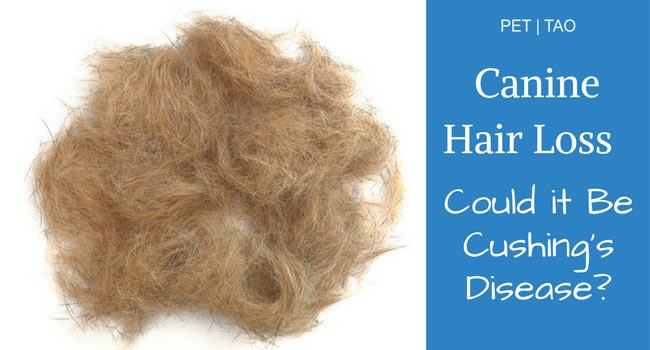Dog hair loss, or alopecia, is often the first sign of an endocrine disease like Cushing’s.
In addition, other skin-related signs of endocrine disease in your dog could be the following:
- Thinning of the skin
- Skin infection or hot spots
- Comedones (blackheads)
- Hyperpigmentation
- Calcinosis cutis (calcium deposition in the skin)
Frequently, however, dog hair loss is the first clinical sign noted.
Does your dog have hair loss?
Hair loss in dogs with Cushing’s disease affects the trunk, sparing the head and distal extremities.
Furthermore, Cushing’s is often associated with other systemic signs, such as polyuria, polydipsia, and polyphagia, and is often accompanied by elevated ALP levels.
For example, a middle-aged dog with truncal hair loss sparing the head and distal extremities should always be evaluated for the possible endocrine disease.
Alopecia X and Hypothyroidism
However, if the dog is negative on Cushing’s test, other diseases should be considered, including Alopecia X and hypothyroidism.
For example, Alopecia X is a clinical disease that primarily affecting Nordic breeds and Toy or Miniature Poodles.
Another name for Alopecia X is Adrenal Hyperplasia-Like Syndrome, thus the relationship to Cushing’s.
During Alopecia X, dog hair loss occurs as early as 1 year of age or as late as 10 years of age.
The primary clinical presentation is the symmetrical gradual loss of hair over the trunk and caudal thighs, sparing the head and front limbs.
Frequently, the skin may become hyperpigmented.
Alopecia X Vs. Cushing’s Disease
The clinical differentiating factor between Alopecia X and Cushing’s disease is that the only sign of Alopecia X is hair loss. No other signs are noted with Alopecia X.
Treatment of Alopecia X includes:
- Spaying or neutering
- Melatonin therapy
- In extreme cases Trilostane
In addition, endocrine disease, called hypothyroidism, is the most common endocrine disease causing hair loss in dogs.
Hypothyroid dogs exhibit the following signs:
- Weight gain
- Sluggishness
- Scaly skin
- Hair loss
- Muscle loss
- Cold intolerance
- Slow regrowth of clipped hair
- Rattail
And, diagnosing thyroid disease in dogs is fairly straightforward.
Total T4 (TT4) concentration is a sensitive but nonspecific screening test and values are low in most hypothyroid patients.
At PET | TAO, we combine the best of both Western and Eastern medicine.
More Powerful Tools for Dog Cushing’s Disease Health Challenges
There are many quick and easy changes you can make at home to help you give your dog an edge on easing Cushing’s disease challenges.
- Learn more about Cushing’s Disease.
- Try Home Cooking. Visit PET | TAO’s Recipe Page, and scroll down to the recipes for dogs with Cushing’s disease. Often, home-cooking makes a huge difference in helping dogs feel better!
- Supplement with medicinal mushrooms. PET | TAO Complement Immune is a Mushroom Blend to ease inflammatory response and immune system stress caused by Cushing’s.
- Try digestive enzymes and probiotics. PET | TAO Harmonize GI boosts gut health, which in turn helps your dog better process all food nutrients. Improved gut health also boosts immunity and calms allergic response.
- Feed Freeze Dried Liver Treats. According to TCVM, when Cushing’s disease is present there is almost always Liver Meridian involvement. Liver treats provide Liver Meridian support like as a glandular supplement (Western theory) and via 5-Element Theory (Eastern theory).
- Learn about natural remedies. A combination of melatonin and lignans supplementation helps many dogs suffering from Cushing’s.
- Learn more about TCVM Herbal Remedies. Chinese medicine offers many amazing natural solutions for Cushing’s disease. A good example is:








